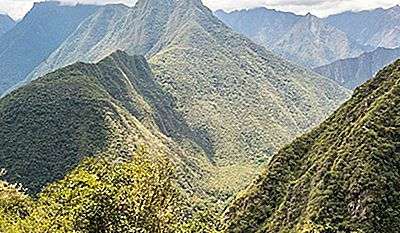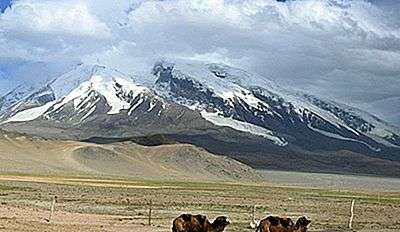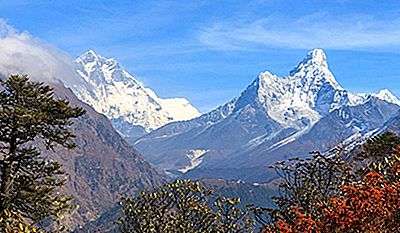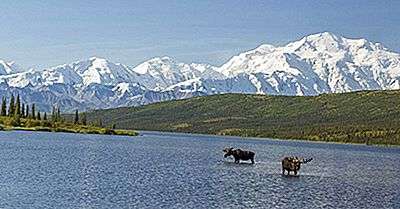Mountain ranges are a series of mountains running on a line or arranged in a line and connected by heights. They are formed by a number of geological processes, the majority of which are formed by plate tectonics. Most of the world’s tallest mountain ranges are located in Asia after the ongoing collision of continental and oceanic plates. The following is a list of mountain ranges by height.
Also Read: The amazing forbidden mountains
10. Alaska Range – 6194 meters above sea level
The Alaska Range is one of the components of the Alaska Mountains which extend 400 kilometers between Lake Clark in Alaska and the White River in the Yukon, Canada. The Alaska Range is a segment of the largest Pacific mountain system in North America and hosts the third highest peak of the seven summits in the world, the Denali. The mountain range is part of the Pacific Ring of Fire and the Denali Fault, which is responsible for a number of earthquakes at the southern edge, and is the climate barrier that separates the interior tundra from the Pacific coastal region. . The huge glaciers of the Alaska range and the panoramic landscapes of the Arctic attract tourists and mountaineers. One of the highest mountain ranges in the world
9. Andes – 6962 meters above sea level

The Andes mountain ranges are the longest continental mountain range in the world located in South America. The Andes extend for 4,300 miles from the southern tip of South America to the northern Caribbean coast through Colombia, Venezuela, Ecuador, Argentina, Peru, Bolivia and Chili. The Andes are the highest peaks in the western hemisphere and are home to the highest mountain peak in South America, Mount Aconcagua. They also form the American Cordillera consisting of a continuous sequence of mountain ranges that form the backbone of North America, South America, Central America and Antarctica. Due to the rotation of the earth,
8. Nyenchen Tanglha – 7162 meters above sea level
The Nyenchen Tanglha (Nyainqêntanglha mountains) forms the eastern part of the southern part of the Tibet Autonomous Region in China. The mountain system includes the northern range of the A-ling Mountains and the southern range of the Kailas range, a rather rugged and glacial region. Nyenchen Tanglha is the subject of folklore among the inhabitants of the Tibetan region. He is also considered to be the most influential deity in much of northern Tibet.
7. Kunlun – 7167 meters above sea level

The Kunlun Mountains are the longest mountain range in Asia, stretching 1,900 kilometers across central China. It forms the northern limit of the Tibetan plateau. Throughout the alignment, the Kunlun consists of three parallel edges rather than a single ridge, like most areas. Because of their location, the Kunlun’s ranges are almost completely isolated from the climatic influence of the monsoons of the Indian and Pacific Oceans, but the climate is rather influenced by the continental air masses. Most of the Kunlun region is covered with steppes and rocky terrain, characterized by desert conditions.
6. Tian Shan – 7439 meters above sea level
The Tian Shan (celestial mountains) form the chains of Central Asia which extend from the border between China and Kyrgyzstan to the former territory of Turkistan. The Tian Shan mountain ranges consist of a series of beaches coupled with valleys and intermediate basins. The Turpan depression in Tian Shan is the lowest region in Central Asia located 504 feet below sea level. Alpine mountain ranges composed of sedimentary and crystalline rocks form ridges in which the glaciation. The mountain glaciers are shrinking rapidly and it is estimated that by 2050, half of the glacier remaining on the mountain will have melted.
5. Hengduan Mountains – 7,556 meters above sea level
The Hengduan mountain ranges are a series of chains located in southwest China, connecting the Tibetan plateau to the Yunnan – Guizhou plateau. The ranges separate the lowlands of Myanmar from those of the Sichuan Basin. These areas were formed by a major volcanic activity occurring in the Indian subcontinent plate in collision with the Eurasian plate. The components of the Hengduan mountain ranges are separated by deep river valleys which carry water from the major rivers of Southeast Asia and form the three parallel rivers of the Tibetan plateau.
4. Pamirs – 7649 meters above sea level

The Pamir mountain range is located on the nodal orogenic uplift (Pamir Knot) from which rise several Asian mountain ranges such as the regions of Karakorum, Hindu Kush, Tian Shan and Kunlun. The word Pamir means tall undulating meadows in the eastern part of the mountains, especially where they are adjacent to Afghanistan and China. The Pamir is located in the Tajikistan region, but its outer limits penetrate into China, Afghanistan and Kyrgyzstan. The heart of the Pamir mountain ranges is found in the highlands of Tajikistan, the highest peak being Gorno-Badakhshan. The Silk Road, considered the longest and most dangerous land route between Europe and China, crosses the Pamir.
3. Hindu Kush – 7708 meters above sea level
The Hindu Kush (Caucasus Indicus) is a 500-mile mountain range that stretches from the Afghan-Pakistan border to northern Pakistan. It forms the western part of the Himalayan region of Hindu Kush and the vast alpine zone made up of the largest hydrographic basin of Central Asia. Hindu Kush has many snow-capped peaks, the highest peak being Terichmi, which overlooks sea level. In many of its features, mountain ranges resemble Karakoram since they meet at the eastern limit of the north. The crossings through the Hindu Kush played a key military role in the invasions of the Indian subcontinent and continue to be an integral part of the modern war in Afghanistan.
2. Karakoram – 8611 meters above sea level
The Karakoram ranges form the great mountain systems of Central Asia and extend 300 miles between Afghanistan and Central Asia. It considered to be the world’s highest mountain ranges. The Karakoram is home to the highest peaks in the world, located nearby, which peak above sea level, including the second highest peak in the world, K25,000. Thanks to their great heights, the Karakoram forms the longest glaciers in the world located outside the polar regions. The slopes of the rows are much less inhibited due to the high altitude, the robustness and the remoteness of the mountains. There are only three inhabited cities in Karakoram with residents dependent on subsistence farming for their survival.
1. Himilaya – 8848 meters above sea level

The Himalayas are the youngest mountain ranges forming the great mountain system of Asia. They create a barrier between the Tibetan plateau in the north and the alluvial plains of the Indian subcontinent in the south. The mountain range includes more than fifty peaks at an altitude of 23,600 feet above sea level, including the highest peak in the world. Everest. The Himalayan ranges extend uninterruptedly for 1,550 miles from the west-northwest to the east-southeast of Nanga Parbat in Pakistan and Namjagbarwa in the autonomous region of China. More than a million people from Nepal, India, Bhutan, China and Pakistan live in the Himalayas and place mountain ranges as crucial to their cultures.
Also Read: Tallest Thailand Mountains

